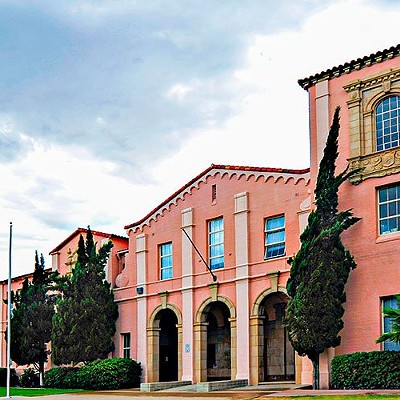For the past six years, many English-language-learner students in Tucson Unified School District schools have been segregated from other students for most of the school day, and have been prevented from participating in the core-curriculum classes that all students need in order to learn and graduate.
For TUSD educator Salvador Gabaldón, it's been especially frustrating to see older English-language-learner students struggle rather than excel. The graduation rate of those students went from 69 percent in 2006 to 35.5 percent last year, according to TUSD statistics.
Gabaldón told the Tucson Weekly he was hopeful when U.S. District Judge David Bury appointed Willis Hawley as the special master to help redevelop a desegregation plan for TUSD. He hoped the plan would help end the daily four-hour segregation of ELL students.
The plan, released by Hawley on Friday, Nov. 9, addresses ELL students throughout—but it does not specifically address the four-hour segregation. Gabaldón said he was disappointed, and that he plans to encourage ELL advocates and families to attend the three public forums and submit comments on the desegregation plan.
Bilingual education has been a longtime source of frustration in the district, and Gabaldón said it is an example of Arizona's anti-Mexican sentiment that reared its head long before the state essentially forced TUSD to end its Mexican American studies program. In 2000, Arizona voters approved Proposition 203, the English for Children initiative, which prevented many Arizona school officials from delivering bilingual education like they wanted, and instead required an English-immersion model.
Back then, the model required that ELL students be put into an immersion program for a year—and no longer. Some districts, like TUSD, were able to obtain waivers and continue their bilingual-education programs. But in 2006, the state Legislature passed a law to limit those waivers and strengthen the law, Gabaldón said.
The Arizona English Language Learners Task Force was created to help implement the law, and the committee extended the model from one year to an indefinite period, until students identified as ELL passed proficiency tests. However, the processes of determining proficiency and how to achieve it have been confusing, Gabaldón said.
At the May 17, 2012, task-force meeting, an argument broke out between several members of the nine-member committee—all appointed by Republican lawmakers—over the four-hour model used by TUSD.
Just before members crossed swords, Gabaldón addressed the task force: "Your unseemly insistence on extensive and punitive segregation for schools with large populations of language-minority students has all the logic of a fetish," Gabaldón said. "It is imperative that the task force work quickly to revise the four-hour model so that it comports at every grade level with the limits on segregation specified by state statute and federal law. Further delay is unconscionable."
The heated exchange at the meeting left Gabaldón hopeful that the committee may be ready to do the right thing. There are other sources of hope, too, such as the U.S. Department of Education's Office for Civil Rights.
The office has already forced the Arizona Department of Education to stop a policy that prevented teachers with accents from teaching ELL students, and to change how students are tested. It also forced the state to continue to ask students and their parents three questions to determine the services they need: What is the first language your child learned to speak? How often is that language used? What language is used other than English in your home?
Attorney Nancy Ramirez, of the Mexican-American Legal Defense and Educational Fund, or MALDEF, which represents Latino students in the TUSD desegregation case, said she understands Gabaldón's frustration over the fact that the four-hour segregation model was not specifically addressed in the plan.
"I can tell you that Sal is right; we, too, are disappointed," Ramirez said. "Other than that, I can't go into the process."
A court order prevents Ramirez and other plaintiff representatives from discussing the negotiations that took place before Hawley made the plan public. But she did point out that as part of the plan, TUSD has agreed to seek a waiver with the state Department of Education's Office of English Language Acquisition Services for an "approved reading block extension to provide access to rigorous mainstream courses and address the literacy needs of ELLs."
Ramirez said that will give TUSD some flexibility with the four-hour model and give students more access to the core curriculum. "I can't predict what will happen, but I also can't stress enough how important it is for people in Tucson to participate during the public-comment period. Go to the meetings, and also comment online."
The plan is available for public review at each TUSD school and online at tucsonusp.com. Public forums run from 6 to 8:30 p.m. on Monday, Nov. 26, at Tucson Magnet High School; Tuesday, Nov. 27, at El Pueblo Regional Center; and Wednesday, Nov. 28, at Palo Verde High School. The public comment period closes Nov. 28.
A revised desegregation plan with any changes will be filed with the court on Dec. 10, and all parties involved in the negotiations have until Dec. 14 to file any objections to those changes.
There is another legal case that could eventually change the state's interpretation of the law and how education is delivered to ELL students—Horne v. Flores. The case, originally filed in 1992 on behalf of students in the Nogales Unified School District, contends that the state inadequately funded ELL programs and services. The Arizona Center for Law in the Public Interest has been fighting the state on this issue since 2000 and has also taken on the state's four-hour segregation policy.
Tim Hogan, the center's director, said a hearing before U.S. District Judge Raner Collins concluded last year, and he continues to wait for a decision on the four-hour segregation model.
"It denies kids access to the academic curriculum they need and segregates them unnecessarily," Hogan said. "Already, a school year has gone by. ... The students come out of this being behind academically, and nobody is going to bring them up to speed."













